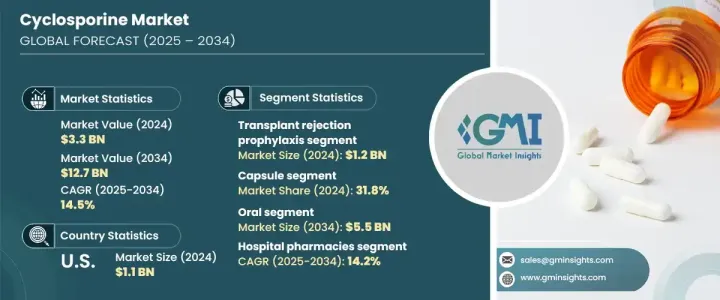
세계의 사이클로스포린 시장은 2024년에는 33억 달러로 평가되었고, 2025년부터 2034년까지 연평균 성장률(CAGR) 14.5%로 성장할 전망입니다. 이러한 놀라운 성장은 주로 장기 거부 반응을 예방하기 위해 면역 억제 요법에 의존하는 장기 이식 절차에 대한 수요 증가에 힘입은 바가 큽니다.

장기 이식 외에도 류마티스 관절염, 건선, 자가면역성 중증 근무력증과 같은 자가면역 질환의 유병률 증가로 인해 시장이 크게 영향을 받고 있습니다. 개발도상국에서 의료 접근성이 지속적으로 개선됨에 따라 사이클로스포린으로 치료받는 환자가 늘어나면서 시장 성장이 더욱 가속화되고 있습니다.
| 시장 범위 | |
|---|---|
| 시작 연도 | 2024년 |
| 예측 연도 | 2025-2034년 |
| 시작 금액 | 33억 달러 |
| 예측 금액 | 127억 달러 |
| CAGR | 14.5% |
첨단 면역 억제 요법에 대한 R&D 투자가 급증할 것으로 예상됨에 따라 향후 몇 년 동안 시장이 빠르게 확대될 것으로 전망됩니다. 2024년에는 이식 거부 반응 예방이 12억 달러로 가장 큰 시장 점유율을 차지했습니다. 이러한 우위는 사이클로스포린이 특히 신장, 간, 심장 이식 환자에서 장기 거부반응을 예방하는 데 중요한 역할을 하기 때문입니다. 이식 기술이 개선되고 수술 후 치료가 발전함에 따라 효과적인 예방 치료에 대한 수요는 계속 증가하고 있습니다.
제형별로 사이클로스포린은 점안액, 용액, 크림 및 연고, 캡슐 형태로 제공됩니다. 자가 면역 질환과 장기 이식을 위한 장기 치료에서 사용 편의성과 효과로 인해 선호되는 형태입니다.
2024년 11억 달러에 달하는 미국 사이클로스포린 시장은 선진 의료 시스템, 면역 억제 치료의 높은 채택률, 자가 면역 질환과 장기 이식의 필요성과 같은 만성 질환의 광범위한 보급으로 인해 선두 자리를 지키고 있습니다. 저명한 업계 기업의 존재와 지속적인 혁신 및 우호적인 환급 정책은 사이클로스포린 시장의 지속적인 성장을 위한 비옥한 환경을 조성합니다.
The Global Cyclosporine Market, valued at USD 3.3 billion in 2024, is expected to experience robust growth at a CAGR of 14.5% from 2025 to 2034. This impressive expansion is mainly driven by the rising demand for organ transplantation procedures, which depend on immunosuppressive therapies to prevent organ rejection. As more people undergo life-saving transplants, the need for cyclosporine to manage immune responses is increasing rapidly.

In addition to organ transplants, the market is being significantly influenced by the growing prevalence of autoimmune disorders such as rheumatoid arthritis, psoriasis, and autoimmune myasthenia gravis. Cyclosporine has proven to be an effective treatment option for managing these conditions, boosting its demand in the pharmaceutical industry. As healthcare access continues to improve in developing regions, more patients are being treated with cyclosporine, further accelerating its market growth. The global push toward increasing awareness of organ donation and the continuous advancements in transplant technologies are also contributing to the increasing usage of cyclosporine.
| Market Scope | |
|---|---|
| Start Year | 2024 |
| Forecast Year | 2025-2034 |
| Start Value | $3.3 Billion |
| Forecast Value | $12.7 Billion |
| CAGR | 14.5% |
With a projected surge in R&D investments for advanced immunosuppressive therapies, the market is expected to expand rapidly in the coming years. The market is segmented by indication, including transplant rejection prophylaxis, autoimmune myasthenia gravis, rheumatoid arthritis, psoriasis, dry eye, and others. In 2024, transplant rejection prophylaxis held the largest share of the market, valued at USD 1.2 billion. This dominance is due to the critical role cyclosporine plays in preventing organ rejection, particularly in kidney, liver, and heart transplant patients. As transplant techniques improve and post-surgical care evolves, the demand for effective prophylactic treatments continues to rise.
When it comes to dosage forms, cyclosporine is available in eye drops, solutions, creams and ointments, and capsules. Capsules accounted for the largest market share in 2024, making up 31.8% of the total market. Their ease of use and effectiveness in long-term treatments, particularly for autoimmune diseases and organ transplants, make them the preferred form. Advances in encapsulation technologies have enhanced cyclosporine's bioavailability and stability, driving further growth in this segment.
The U.S. cyclosporine market, valued at USD 1.1 billion in 2024, stands as a leader due to its advanced healthcare system, high adoption rates of immunosuppressive treatments, and the widespread prevalence of chronic conditions like autoimmune disorders and the need for organ transplants. The presence of prominent industry players, coupled with continuous innovation and favorable reimbursement policies, creates a fertile environment for the sustained growth of the cyclosporine market.